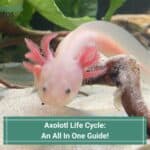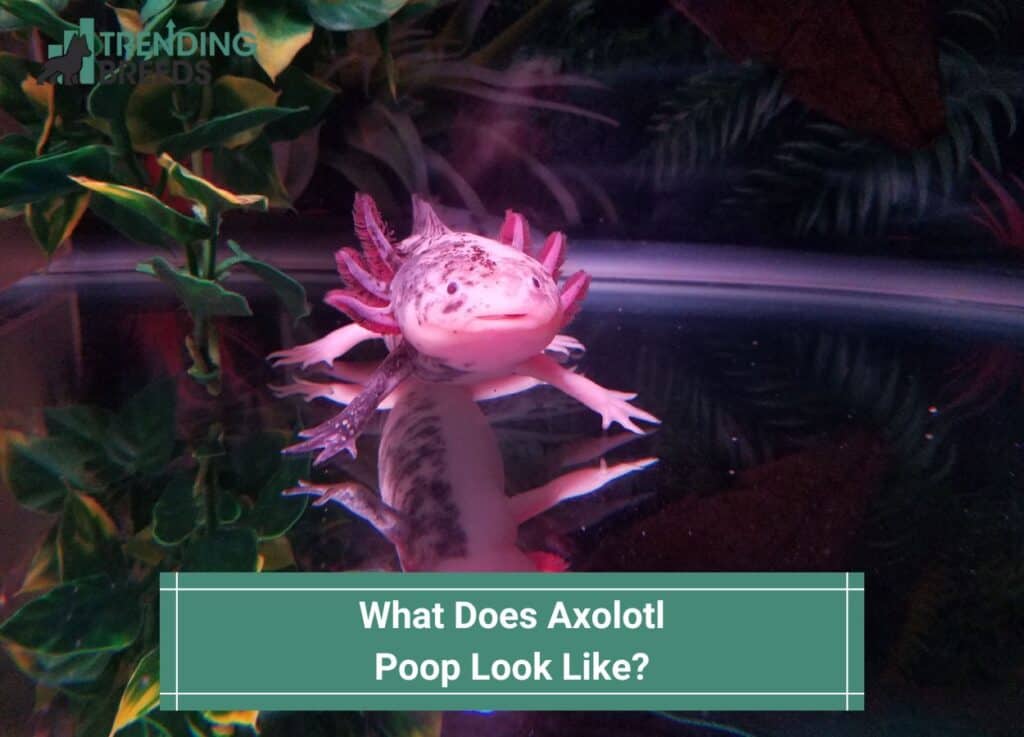
As unique and captivating creatures, Axolotls naturally generate waste like any other animal. If you’re inexperienced in caring for an Axolotl, you might have questions regarding their defecation frequency and axolotl poop.
An Axolotl’s poop looks like any other animal’s poop, with slight differences.
If you are a pet owner of this slippery creature, you must familiarize yourself with its poop pattern and texture and needs to decipher between healthy and unhealthy behavior.
By distinguishing between healthy and unhealthy excrement and recognizing the significance of regular tank maintenance, you’ll acquire the necessary knowledge to ensure a clean and thriving living environment for your Axolotl.
Read on to learn more.
Before you scroll further down this guide, check out these other animal-related articles: Squirrel Poop Vs Rat Poop: What Do They Look Like? and What Does Garter Snake Poop Look Like?.
Table of Contents
What Does Axolotl Poop Look Like?
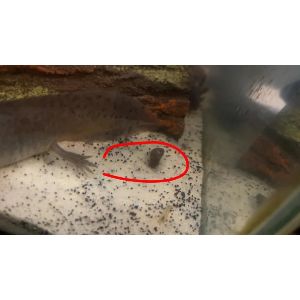
Axolotl poop shares similarities with that of other creatures.
If you’re considering getting an axolotl as a pet, observing their feces is essential as it can provide valuable insights about their health.
When an Axolotl needs to defecate, you may notice changes in its posture and reddening of its gills.
One crucial aspect to note is that mishandling axolotl waste during cleanup can result in “explosions,” which you should avoid due to the ammonia content in their excrement.
Axolotl feces typically come wrapped in a thin casing resembling a sausage.
They often exhibit a dark black or brown color, measure around an inch in length, and weigh approximately 0.04 ounces (1 gram).
Cleaning up Axolotl feces can be challenging since you’ll need to watch your pet, as they only eliminate waste once or twice a week as adults.
If left unattended, Axolotl waste dissolves and contaminates the tank.
Additionally, exercising caution when cleaning the tank is crucial to avoid rupturing the sausage casing and causing contamination.
The Appearance of Unhealthy Axolotl Poop
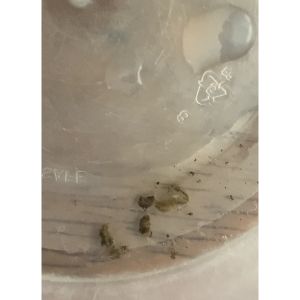
Unhealthy Axolotl excrement exhibits distinct characteristics that differentiate it from healthy feces.
One noticeable sign of illness is the presence of large chunks of flesh around the anal sac area of the Axolotl.
If you observe such abnormality, it is crucial to provide immediate attention and seek appropriate care for your Axolotl.
Another indicator of unhealthiness is the appearance of white poop.
If your Axolotl’s stool is white, it signifies the presence of parasites.
That suggests that your Axolotl may be experiencing a parasitic infection and requires prompt attention and treatment to ensure its well-being.
How Many Times Does Axolotl Poop?
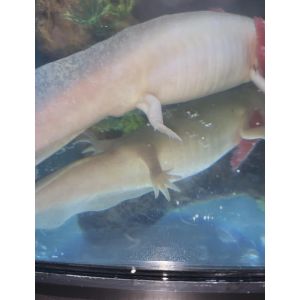
Various factors influence the frequency of axolotl feces. In general, healthy adult Axolotls typically defecate once per week.
That is due to their slower metabolisms, digestive systems, and the feeding schedule they follow.
Unlike newborn axolotls, adult Axolotls require less food to sustain slower growth.
Depending on factors such as appetite, age, and environmental conditions, Axolotls can thrive on a feeding regimen of one meal every other day.
The infrequent defecation of Axolotls is a result of their lengthy digestion process. Moreover, the ambient temperature influences their digestive system’s effectiveness.
Axolotls are cold-water amphibians that thrive best in temperatures ranging from 60 to 64°F (15 to 18°C).
However, they can tolerate slightly warmer temperatures as their natural habitat may not always provide ideal conditions.
It’s important to note that higher ambient temperatures can lead to quicker digestion and more frequent bowel movements in Axolotls.
Keeping the temperature within the recommended range is essential to maintain the health of your Axolotl and prevent potential health issues.
A cooler climate for Axolotls is necessary for their long-term comfort and well-being.
Is it Normal When Axolotls Eat Their Poop?
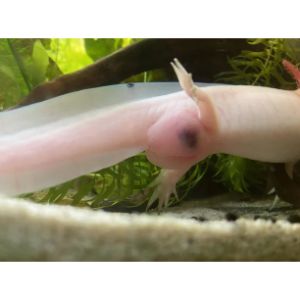
Axolotls have a natural aversion to consuming their excrement.
However, they may eat it in emergencies if they are starving or experiencing nutritional deficiencies due to improper dieting.
As carnivorous amphibians, Axolotls require a diet rich in protein and fat.
Nutritious and well-balanced food options for Axolotls include blackworms, earthworms, brine shrimp, daphnia, and raw meat.
Feeding frequency is also important. Depending on Axolotl’s size, appetite, and nutritional requirements, they typically need a substantial meal every two to three days.
If your Axolotl exhibits poop-eating behavior, it may be necessary to increase the feeding frequency or change the types of food provided.
It is crucial to provide a diversified diet to ensure your Axolotl receives adequate nutrition.
In the wild, Axolotls naturally consume various food items, and their bodies require this diversity.
Poop-eating behavior in Axolotls is concerning because it puts them at risk of parasite infections, regardless of the underlying cause.
If you notice your Axolotl suddenly engaging in poop-eating behavior, it is crucial to take immediate action to address the issue and seek appropriate care for your Axolotl.
Are Axolotls Poop Stinky?
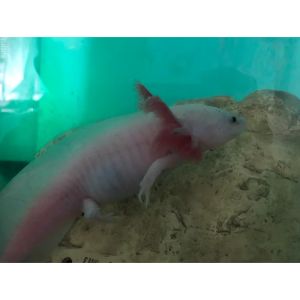
Axolotl excrement does possess a specific unpleasant odor, but it is not typically overpowering.
However, if you notice a strong and unpleasant smell coming from your Axolotl tank, it is likely a result of improper tank maintenance.
Under normal circumstances, the water in your Axolotl’s habitat should not have a foul odor, even if the animal has defecated.
That is assuming you are consistently maintaining clean water conditions.
If you neglect regular tank maintenance and skip cleaning days too frequently, the habitat of your Axolotl will eventually develop a foul odor.
That indicates that the compounds in the animal’s feces have altered the composition of the water.
Additionally, your Axolotl may display signs of stress and potentially even ammonia poisoning.
In such situations, the odor will be the least of your concerns, and it becomes crucial to address the underlying issues promptly.
Ways to Clean Axolotl Poop
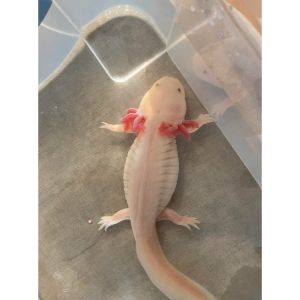
Cleaning Axolotl waste can be a straightforward process if approached with some cleverness.
It’s essential to avoid holding the stool in a way that could cause it to break apart.
Despite its appearance, the stool is not solid, and poking it will cause it to disintegrate and scatter throughout the tank.
To prevent any issues, it is crucial to promptly scoop up the stool as soon as you notice it.
Allowing it to disperse inside the tank will increase the ammonia levels in the water.
Elevated levels of ammonia can be harmful to your Axolotl, potentially even leading to its death.
Therefore, it is vital to maintain a clean tank environment and promptly remove any waste to ensure the well-being of your Axolotl.
Using a Turkey Baster
A convenient tool for cleaning axolotl excrement is a turkey baster. Using a turkey baster is a simple and effective method. Here’s how to do it:
- Position the turkey baster’s nozzle close to the axolotl stool
- Squeeze and release the bulb of the turkey baster to create suction.
- As you release the bulb, the baster will draw in the excrement.
- Dip the baster into the tank, submerging it in the water to prevent any residue from escaping.
- Be mindful of selecting an appropriately sized turkey baster. If needed, you can cut down the end of the baster to facilitate the cleaning process.
Using a turkey baster allows for targeted cleaning and helps remove axolotl waste efficiently, keeping the tank clean and maintaining water quality for the well-being of your Axolotl.
Using a Gravel Vacuum Cleaner to Clean Out the Poop
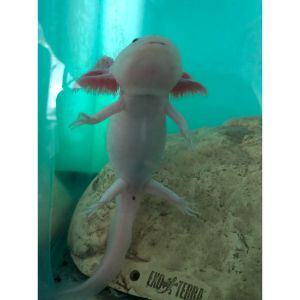
Cleaning up Axolotl waste can be made more convenient using a gravel vacuum.
This tool serves the dual purpose of removing contaminated water and picking up the excrement.
Here’s how you can effectively utilize a gravel vacuum for this task:
- Many standard gravel vacuum nozzles are not ideal for cleaning axolotl waste. To address this, you can modify the nozzle by cutting off a portion to widen the end.
- Since you are explicitly targeting Axolotl stool and not vacuuming the gravel, you can omit using the bulky head portion of the vacuum. Remove this part, and use only the tube section.
- Position the head of the vacuum near the excrement by submerging it into the tank. Allow the siphoning force to draw in the waste.
- Once you have extracted all the stools, remove the vacuum from the tank and release the waste into a container. Repeat the process as needed.
Using a gravel vacuum offers the added benefit of keeping your Axolotl tank clean and healthy by removing axolotl feces, dead plant matter, uneaten food, and other debris.
This tool helps maintain water quality and ensures a conducive environment for your Axolotl’s well-being.
What Happens If You Don’t Clean Axolotl Poop?
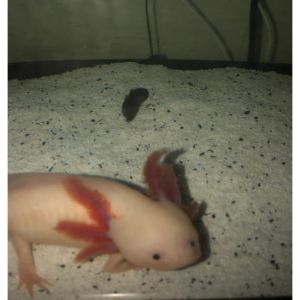
It is correct that Axolotl feces is not inherently harmful to Axolotls or humans.
However, the presence of ammonia in the feces can hurt water quality.
Axolotls are sensitive to changes in water parameters and exceptionally high ammonia levels (NH3).
When ammonia levels in the tank rise too high, it can be detrimental to the health of Axolotls.
They may experience ammonia burns and ammonia poisoning as a result.
To prevent such issues, it is crucial to regularly perform water changes and use a gravel vacuum to clean the tank.
More than simply relying on water filtration alone is required, as it does not remove the Axolotl waste present in the tank.
Performing water changes and vacuum-cleaning the tank at least once every few weeks is essential for maintaining clean water and improving the overall lifespan and well-being of your Axolotl.
Keeping the water clean creates a healthier environment for your Axolotl.
FAQs About Axolotl Poop
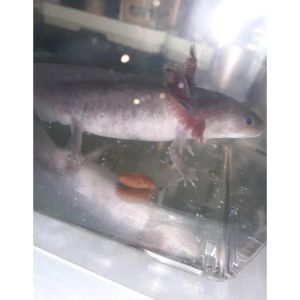
Is Axolotl poop hard?
No, Axolotl poop is not hard. It typically has a soft and malleable consistency.
The feces of an Axolotl can easily break when handled, and it should be flexible and smooth in texture.
How do I get my Axolotl to poop?
You cannot directly control getting an Axolotl to poop, as it is a natural bodily function.
However, there are a few things you can do to promote a healthy digestive system and regular bowel movements for your Axolotl:
Maintain a proper diet
Ensure your Axolotl has a balanced and appropriate diet. Feed them high-quality food such as blackworms, earthworms, brine shrimp, daphnia, and raw meat.
A nutritious diet helps support proper digestion and regular bowel movements.
Feeding schedule
Stick to a consistent feeding schedule based on the age and size of your Axolotl.
Avoid overfeeding, as excess food can lead to digestive issues and irregular bowel movements.
Water temperature
Maintain the water temperature within the recommended range for Axolotls (around 60-64°F or 15-18°C).
The ideal temperature helps optimize their digestion and metabolic processes.
Tank cleanliness
Keep the tank clean and maintain good water quality.
Regularly remove any uneaten food or debris that could contribute to water contamination and digestive disturbances.
Remember, axolotls have individual variations in their digestive systems, and it is normal for them to poop less frequently than other animals.
As long as your Axolotl is active, eating well, and showing no signs of distress or illness, infrequent bowel movements should not be a cause for concern.
How do I know if my Axolotl is impacted?
Detecting impaction in an Axolotl is essential for their well-being. Here are some signs that may indicate your Axolotl is impacted:
Decreased appetite
A sudden loss of interest in food or a significant decrease in appetite can signify impaction.
If your Axolotl refuses to eat or eats significantly less than usual, it could indicate a blockage in the digestive system.
Bloated abdomen
An Axolotl with impaction may have a visibly swollen or distended abdomen.
The belly may appear larger than usual, indicating a buildup of material in the digestive tract.
Difficulty swimming or floating
Impacted Axolotls may exhibit problems in swimming correctly. They might struggle to maintain balance, flow abnormally, or tend to sink to the bottom of the tank.
Abnormal feces
If your Axolotl’s poop is tiny, discolored, or irregular, it could be a sign of impaction. Look for any changes in the appearance or frequency of their bowel movements.
Lethargy or unusual behavior
An impacted Axolotl may become lethargic, lacking energy or enthusiasm.
Axolotl may also exhibit unusual behavior, such as excessive hiding, reduced movement, or spending prolonged periods at the bottom of the tank.
If you observe any of these signs or suspect that your Axolotl has an impact, it is essential to take action promptly.
Consult with a veterinarian experienced in treating axolotls to receive proper guidance and assistance.
They can provide a thorough examination and recommend appropriate measures to alleviate the impaction and restore your Axolotl’s health.
Are Axolotls good pets for beginners?
Yes, Axolotls can make good pets for beginners, especially those interested in aquatic species. Here are some reasons why Axolotls can be suitable for beginner pet owners:
Low maintenance
Axolotls are relatively low-maintenance pets. They require less attention and care than demanding pets like dogs or cats.
They don’t require daily walks or constant social interaction.
Small space requirements
Axolotls are aquatic creatures that primarily live in water. They can stay in a tank or aquarium, which makes them suitable for small living spaces.
However, providing an adequately sized tank ensures their comfort and well-being.
Fascinating and unique
Axolotls are intriguing creatures with exceptional appearance and regenerative abilities.
They have external gills, feathery external gill stalks, and a permanently larval form, which makes them visually captivating pets to observe and learn about.
Hardy and resilient
Axolotls are generally hardy and can tolerate various water conditions.
They can adapt well to changes in their environment, which can be advantageous for beginner pet owners who are still learning about proper tank maintenance and water parameters.
Limited dietary needs
Axolotls have specific nutritional requirements, but their diet mainly consists of available live or frozen food such as worms and shrimp.
Feeding them is relatively straightforward, and they do not require complex diets.
However, it’s important to note that Axolotls still require proper care and attention.
Researching and understanding their needs is crucial, including tank setup, water parameters, and appropriate feeding.
Monitoring water quality and temperature is also necessary to ensure their well-being.
Consulting with experienced Axolotl owners or a veterinarian specializing in aquatic species can provide further guidance for successful Axolotl care.
What Does Axolotl Poop Look Like?
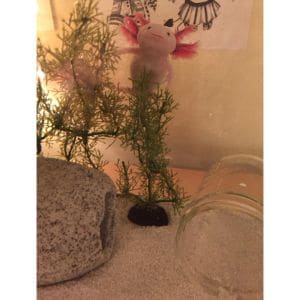
Axolotls can be excellent pets for beginners, particularly those interested in aquatic species.
Their unique appearance, low maintenance requirements, and fascinating regenerative abilities make them captivating companions to observe and care for.
With their small space requirements and relatively specific dietary needs, axolotls can easily fit into various living situations.
While hardy and adaptable, beginner owners must research and understand their particular care requirements, such as tank setup, water quality, and feeding habits.
Regular monitoring and proper attention to their environment will ensure the health and well-being of these remarkable creatures.
With the right knowledge and care, Axolotls can provide years of enjoyment and wonder as pets for beginners and experienced owners alike.
If you find this guide, “What Does Axolotl Poop Look Like,” informative and helpful, you can check out these other animal-related articles from our team:
- What Does Possum and Raccoon Poop Look Like?
- Why Does Dog Poop Turn White?
- Why Do Puppies Eat Their Poop?
You can learn more about axolotls by watching “10 Fun Facts About AXOLOTLS” down below:


